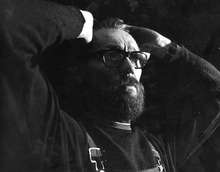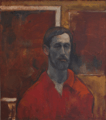Václav Turek
| Václav Turek | |
|---|---|
 Photo portrait of Vaclav Turek | |
| Born |
July 2, 1924 Šahy, Czechoslovakia |
| Died |
January 29, 1988 (aged 63) Prague, Czechoslovakia |
| Nationality | Czechoslovak |
| Education | Academy of Fine Arts, Prague |
| Known for | Painting, Drawing, Sculpture, Graphics |
Václav Turek (1924– 1988) was a professional Czechoslovak painter, graphic artist and sculptor. In his practice he alternated between figurative themes as well as landscape paintings, with a polarization of opinion between abstraction and modern Realism (arts). There is an evident reflexion of the climactic period of classical European and Czech modern painters in his work, in his distinctive interpretation tinged with a delicate atmosphere of a cultivated diversity of colour and light organization. The works of Václav Turek integrate fundamentally into the evolution of Czech modern art.
Life
Painter Václav Turek was born on 2 July 1924 in Šahy, Czechoslovakia to a family of a Czech construction engineers. The family moved to Prague in 1937.
Studies and teaching activities
Václav Turek studied at the National Graphic School under professors J. Vodrážka and K. Müller and afterwards at the Academy of Fine Arts in Prague (AVU) in prof. Vlastimil Rada's studio (1945-1950). His generational colleagues were Oldřich Oplt, Josef Jíra, Ladislav Čepelák, Vladimír Tesař, Bohdan Kopecký and others. In the years of 1962-1965 he got an internal research fellowship at AVU, worked as an assistant in prof. V. Rada's studio and eventually in prof. Karel Souček's atelier. From the beginning of the 70s until his death in 1988 he led a separate figure drawing class (the so-called “Evening Nude”) at AVU. Hundreds of students went through his hands, which not only gained the basics of this fundamental discipline from his resourceful and intensely run classes but also an important life lesson. His abilities to pin down substance, point out a mistake, adjust a lost aspect with one stroke of charcoal and encourage a fight at the beginning of a struggle were proverbial and admirable. He never joined the communist party, which together with his sister's emigration made any kind of a career promotion impossible. He spent the whole of his pedagogical path as a senior assistant, perhaps the only and longest serving one in the history of the Fine Art Academy in Prague.
Work
Václav Turek's practice includes painting, graphic art, drawing, art protis and sculpture. During his life he never quite fit into society's taste of the period. He was too Avant-garde and uncommitted in the times that praised realism and too realistic in the “avant-garde” times. There is an evident reflexion of the climactic period of classical European and Czech modern painters in his work, in his distinctive interpretation tinged with a delicate atmosphere of a cultivated diversity of colours and light organization. The works of Václav Turek integrate fundamentally into the evolution of Czech modern art.
In 1962 on the occasion of his first solo exhibition V. Rada wrote: “Václav Turek strives for expressing what he feels and what he has been through. They are experiences more internal than visual. I see his world, the world of his visions narrows but also focusses. Above all we are dealing with a man, his face and his fate. Everything is expressed with contemporary, low-cost and often persistent tools.”
In later years, landscape painting pushed cityscapes and portrait painting to the background. His emerging hearty relationship to Southern Bohemia had a significant influence on this change. The main subject matter of his paintings became the geometrical lines belonging to the village houses' gables. Again and again in never-ending variations he placed blocks and triangles into the magical space of a landscape, out of which he assembled village houses. One can feel a pulsating life behind their walls, but it is hidden, mysterious, often surrounded by a melancholic haze. Having been present to the sad transformation of the traditional village into a heterogeneous hybrid of generic plastering, three-part windows and blocks of flats, he attempted to capture the scenery of stonewalls, baroque gates and dusty paths with flocks of geese, disappearing together with the magic of cleanliness and a feeling of deep belonging to a world of ancient traditions and certainties rising out from the past. His experience of a concrete reality is always supported by a delicate base.
Already from the original lyrical representation do the paintings emit a great inner power and concealed dynamics which work their way up into a distinctive low-cost look purposefully suppressing colour diversity.
His paintings were not created effortlessly, it was always a fair and persistent fight and it took a long time before he was willing to consider a painting finished. He almost tangibly inserted a piece of himself into each painting, which is why his work radiates a mysterious energy and feelings of downfall which is the case with his pieces after 1968. His practice was concluded prematurely in the second half of the 70s, when he stopped making art due to health and gradually also psychological problems caused by the hopeless situation the society was in. He died in January 1988 without living to see the political changes he had been waiting for his whole life.
Gallery
References
From texts and manuscripts written by Vlastimil Rada, Miroslav Rataj, Jiří Kotalík, Jan Kotalík a compiled by Dagmar Dreslerová
Dreslerová, D. – Stejskal, A. – Beneš, J. 2003: Historická krajina severního Prácheňska. – The Historic Landscape of North Prácheňsko. Písek: Prácheňské nakladatelství













